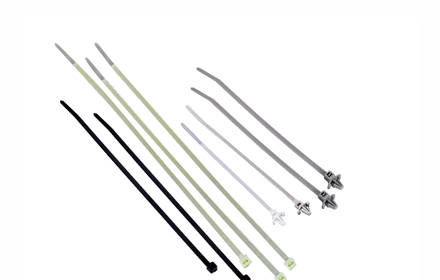Cable Ties are essential tools used in a wide range of applications, from organizing cables and wires to securing hoses and other items in various industries. Whether you're organizing your home or working in a high-demand industrial environment, Cable Ties are an indispensable part of day-to-day operations. But have you ever wondered what cable ties are made of? In this article, we'll explore the materials commonly used in the manufacturing of cable ties and the reasons behind their strength, durability, and versatility.

The Most Common Material: Nylon (PA66)
The most common material used for manufacturing cable ties is Nylon 66 (PA66). Nylon is a type of polymer that is well-known for its exceptional mechanical properties and overall strength. The key reasons why PA66 is favored for cable ties are its high tensile strength, flexibility, abrasion resistance, and long-lasting durability.
Why Nylon PA66?
High Strength: Nylon PA66 offers superior strength, making it an ideal choice for bundling multiple cables, wires, or even heavy objects. It has the ability to handle significant tensile force without breaking or losing its structural integrity.
Flexibility and Durability: Nylon PA66 remains flexible even in colder temperatures, making it easy to wrap around objects. Additionally, it is resistant to wear and tear, ensuring long-lasting performance in challenging conditions.
Resistance to Harsh Environments: PA66 is highly resistant to various environmental factors such as UV rays, moisture, oils, and chemicals. This makes it suitable for both indoor and outdoor use in diverse settings.
Temperature Resistance: Nylon PA66 cable ties can typically function in temperatures ranging from -40°C to 85°C, with some variants even performing well in more extreme conditions.
Other Materials Used for Cable Ties
While Nylon PA66 is by far the most common material, cable ties are also manufactured from other materials to meet specific performance requirements or environmental conditions. These materials include:
1. Stainless Steel
For extreme durability and strength, stainless steel cable ties are often used. These ties are commonly used in industrial, automotive, and construction applications. Stainless steel cable ties are corrosion-resistant and can endure high heat, making them an ideal choice for harsh environments where traditional plastic cable ties may not be suitable. They are perfect for environments with high moisture, heat, and chemical exposure, such as in marine or chemical industries.
2. Polyester (PET)
Polyester cable ties offer good resistance to UV rays, heat, and chemicals. They are often used in applications that require a tie that is both strong and resistant to weathering. Polyester ties are commonly found in outdoor installations, electrical work, and environments where UV exposure is a concern, as they maintain their structural integrity over time.
3. Polypropylene
While not as commonly used as nylon, polypropylene (PP) cable ties offer chemical resistance and are often used in food processing or pharmaceutical applications. These ties have moderate strength compared to nylon but are ideal for non-demanding applications where resistance to chemicals and moisture is more critical than tensile strength.
Specialty Cable Ties
In addition to the standard nylon and stainless steel varieties, specialty cable ties are manufactured for specific applications that require enhanced capabilities. These include:
1. Flame Retardant Cable Ties
Flame retardant cable ties are designed to meet UL 94V-2 fire safety standards. They are made using a modified nylon that is capable of preventing the spread of fire. These ties are essential in electrical installations or areas with fire safety concerns, where reducing fire hazards is a priority.
2. UV Resistant Cable Ties
Cable ties exposed to outdoor environments are susceptible to UV degradation, which can make them brittle over time. UV-resistant nylon cable ties are formulated with additives that prevent the material from breaking down when exposed to sunlight. These ties are ideal for outdoor use, such as securing landscape cables or solar panels.
3. Heavy Duty Cable Ties
Heavy-duty cable ties are made from high-strength nylon or stainless steel and are designed to support high loads. These ties are used in industrial applications where cables or hoses are bundled tightly and require a secure and stable hold. They can withstand higher tensile forces, making them suitable for construction, automotive, and heavy equipment industries.
Why Choose Nylon for Cable Ties?
Nylon, especially Nylon 66, has become the industry standard for cable ties due to its unique combination of strength, flexibility, and resistance to various environmental conditions. Here’s why it is the preferred material:
1.Versatility: Nylon cable ties can be used in a wide range of environments, from electrical installations to outdoor and automotive applications. They offer reliability in various climates, from hot deserts to freezing cold environments.
2.Cost-Effective: Compared to other materials like stainless steel or polyester, nylon cable ties are cost-effective without compromising on quality. This makes them a popular choice for both consumer and industrial use.
3.Easy to Use: Nylon is lightweight and flexible, making it easy to manipulate and install cable ties quickly and efficiently. This simplicity makes them ideal for both DIY projects and professional applications.
4.Safety: With a range of safety features like flame retardancy and UV resistance, nylon cable ties can enhance safety in various situations, reducing the risk of fires or material degradation over time.
Cable ties are made from a variety of materials, with Nylon PA66 being the most common due to its exceptional strength, flexibility, and resistance to environmental factors. For specialized applications, other materials such as stainless steel, polyester, and polypropylene are used. Whether you're bundling cables, securing hoses, or organizing cables in an industrial environment, understanding the materials that make up your cable ties ensures you select the right product for your specific needs.





 English
English
